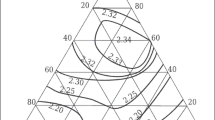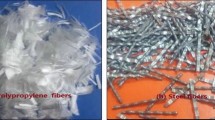Heat-resistant medium-cement concrete with calcium aluminate filler is studied. It is established that addition of carbon fiber facilitates an increase in concrete strength in compression and thermal stability. Explosive breakage only does not occur for specimens with polypropylene fiber on heating a concrete specimen at a rate of 40°C/min to 1000°C.
Similar content being viewed by others
Explore related subjects
Discover the latest articles, news and stories from top researchers in related subjects.Avoid common mistakes on your manuscript.
Introduction
Metal and organic fibers, fulfilling specific functions, are mainly used in heat-resistant concretes. Steel fibers improve concrete mechanical properties and increase its thermal shock resistance, retarding crack propagation [1, 2]. The limiting temperature for use of steel fibers is about 1200°C. Organic fibers (polypropylene, from polyaramides, etc.) in dense and deflocculated concretes, are required in order to provide removal of water vapor during drying and the first firing [3, 4], since these concreates are inclined towards explosive breakage on rapid heating [5, 6]. Fibers provide shrinkage and melt at 150°C, and water vapor is removed from concrete through microchannels created within its structure.
Attempts have been made to use in heat-resistant concrete ceramic fibers, used in manufacture of refractory heat insulation objects [1], and aluminosilicate fibers, prepared by a plasma method [7]. However, no significant effect was achieved. As a rule, these fibers react at high temperature with other concrete components and become an integral part of a material.
Carbon fibers are used quite extensively for dispersed reinforcement of concrete normally used in civil construction in order to improve its physicomechanical properties and prevent formation of deformation cracks. There is some interest in the results of research obtained using mechanically activated carbon fiber in autoclave concrete [8, p. 362 – 371]. It was shown in the work that fine particles of carbon fibre, formed with mechanical treatment, exhibit an activated surface that serves as crystallization centers during binder material hardening. As a result of this there is an increase the crystallinity of new formations, and autoclave concrete mechanical properties are improved.
Consideration was given in [9] to micromechanics of short glass and carbon fibers in a concrete matrix. The dynamics of pull-out and stress field were studied around a single fiber, pulled from a matrix. The main stages of the process were established.
Carbon fibers oxidize in air at elevated temperature. The temperature of its prolonged operation is 300 – 400°C, and under conditions of short-term heating in inert or reducing atmospheres a fiber withstands a temperature of 1500 – 2000°C [10]. There is interest in using these fibers in heat-resistant concrete for reinforcement in the drying stage and the first firing in order to prevent crack formation and reduce the danger of explosive breakage.
In this work the effect of carbon fibers on properties of medium cement heat-resistant concrete were studied, concentrating attention on concrete mechanical properties and crack formation with thermal shocks and rapid heating.
Research Materials and Methods
In performing studies high-alumina cement Gorkal-70 (containing not less than 70% Al2O3) and filler, prepared from clinker grade Gorkal 50 (not less than 50% Al2O3) from GórkaCementSp. zo.o.; microsilica grade RW-Fuller from RWSilicium GmbH (96.1% SiO2), calcined alumina grade CTC-20 from Almatis (99.7% Al2O3), and deflocculants, i.e., polycarboxylate ester grade Castament FS 20 from BASF, and sodium tripolyphosphate, were used The clinker phase composition grade Gorkal 50, %: CaAl2O4 64.2 ± 0.2, Ca2Al4O7 0.9 ± 0.2, Ca3Al6O12CaSO4 3.0 ± 0.1, Ca3Al(Al,Si)2O7 26.8 ± 0.1, Ca12Al14O33 0.5 ± 0.1, CaTiO3 4.5 ± 0.1.
Carbon fiber (CF) was used as an additive to concrete compositions, whose average length was 5 mm, average diameter 6.5 μm. The carbon content in fiber was 98%. Fiber morphology is shown in Fig. 1.
Three main compositions of heat-resistant concrete (A0, A1, and A2) were studied, presented in Table 1. In addition, specimens of concrete A3 with addition or propylene fiber were prepared solely in order to study explosive breakage.
Dry mixing of fiber with concrete components (or cement composition) was carried out in a Eirich R02E high-speed mixer for 2 min, and with water in a Hobart planetary mixer for 3 min. The temperature during specimen preparation and component temperature during mixing was 20 ± 1°C.
Concrete specimens 70 × 70 × 70mm and 40 × 40 × 160mm were fired at 800, 1100, and 1200°C, and the indices of the main physicomechanical properties were established in accordance with specifications of LST EN ISO 1927 – 6:2013. Concrete thermal shock resistance was determined according to GOST 20910 by heating to 950°C and water cooling. The heating-cooling cycles were continued to a 20% weight loss for a specimen 70 × 70 × 70 mm.
Concrete explosive breaking resistance was evaluated on heating cylindrical specimens with diameter and thickness of 36 mm at a rate of 20, 30, and 40 °C/min to 1000°C. Studies were carried after three days of concrete hardening. Specimen weight loss was determined during heating as a result of removal of free moisture and hydration water.
Concrete specimens and their surface were photographed in a Canon INC PC1057 camera.
Results and Discussion
A study of concrete specimens strength (Fig. 2) showed that ultimate strength in compression σco for medium-cement concrete with calcium aluminate filler after drying at 110°C increased to 140 – 170 MPa, compared with strength after hardening, which was 70 – 90 MPa. After firing at 800 – 1200°C σco was not less than 95 MPa.With addition of CF the strength of concrete specimens A1 and A2 increased compared with this index for the concrete control composition A0. The increase in strength of concretes A1 and A2 after introducing CF:
Heat treatment | |||||
temperature, °C . . . . . . | After three days hardening | 110 | 800 | 1100 | 1200 |
Increase strength | |||||
compared with σco of concrete A0, %. . . . . | ≤30 | ≤20 | ≤30 | ≤20 | ≤20 |
A possible explanation for the reason of an increase in concrete strength is given by a study of the microstructure of cement stone (after three days of hardening) with addition of CF (water-cement ratio W/C = 1, CF content 0.02% (above 100%)). Analysis of the photographs obtained shows that in the contact zone with CF (Fig. 3 a) there is formation of dense hydrated microzones (Fig. 3 b)
The following equations were used in the work [11]:
where N/VC is amount of CF for cm3 of concrete; ρ is volumetric amount of fiber in concrete, d and L are average fiber diameter and length respectively; S is distance between fibers.
According to calculations performed by Eqs. (1) and (2) [11], the amount of CF in 1 cm3 of concrete N/VC reaches 370 and 720, and distance S between fibers is 3.0 and 3.4 mm for compositions A1 and A2 respectively. This means that the amount of possible compacted microzones in cement stone of concrete is significant.
A favorable effect of adding CF has been noted in studying concrete thermal shock resistance. The thermal shock resistance of concrete specimens A1 and A2 with CF was 9 – 10 heating-cooling cycles, which is 20 – 30% more than for concrete A0 without CF addition. Thermal shock resistance, number of 950°C – water cycles: A0 7, A1 10, A2 9.
The nature of crack formation at a specimens surface is interesting: without CF it is occurrence of several coarse cracks, and with addition of CF it is formation of a fine crack network (Fig. 4). It is possible that the fragmented structure formed in concrete increases its thermal shock resistance.
Studies of concrete explosive breakage resistance showed that on heating cylindrical specimens at a rate of 20 and 30°C/min to 1000°C specimen breakage of the test compositions does not occur. However, with an increase in rise temperature rate to 40°C/min there is concrete specimen breakage both without CF and with added fiber (Fig. 5 a, b, c). In addition, concrete A3 studied with addition of polyprolylene fiber did not break (Fig. 5 d). It should be noted that specimens with addition of CF break into a larger number of fragments (see Fig. 5 b, c) compared with the composition without CF (see Fig. 5 a).
Specimen weight loss curves (Fig. 6) showed that in concrete A3 with polypropylene fiber moisture is removed more rapidly at above 250°C (specimen temperature at a depth of 2 mm) than in concretes A1, A1, and A2. In this case polypropylene fiber melts, and water vapor is removed without hindrance from a concrete specimen through the microchannels formed.
In concretes A0, A1, A2 weight loss curves hardly differ, but at about 600°C there is separation of curves signifying explosive breakage of the test specimens. Consequently, CF under the test conditions do not burn off and a possible reinforcing effect did not develop.
Conclusion
Action of carbon microfibers on the properties of medium-cement heat-resistant concrete with calcium aluminate filler has been studied. It was established that addition of carbon fiber facilitates an increase in concrete strength in compression both after hardening and after drying and firing at 800, 1100, and 1200°C. With thermal shocks a fragmented structure forms in concrete specimens, increasing concrete thermal shock resistance. However, addition of carbon fiber does not have much effect on concrete resistance to explosive breakage.
References
I. Allenshtein, et al., (G. Rouchka and H. Wutnau, editors) Refractory Materials. Structure, Properties, Testing: Handbook [Russian translation], Intermet Inzhiniring, Moscow (2010).
J.Wojsa, A.Wrona, and K. Czechowska, “Thermal shock resistance parameters for refractories,” Proc. Internat. Conf. Refractories, Furnaces and Thermal insulations. Podbanske-High Tatras, Slovakia, 8 – 10 June 2004.
C. M. Peret, R. Salomao, A. M. Zambon, et al., “Polymeric fibers and the drying of refractory castables,” 58th Congresso Annual da ABM (2003).
M. D. M. Innocentini, R. Salomao, C. Ribeiro, et al., “Permeability of fiber-containing refractory castables,” Amer. Ceram. Soc. Bull., 81(8), 65 – 68 (2002).
M. D. M. Innocentini, F. A. Cardoso, M. M. Akyioshi, et al., “Drying stages during the heating of high-alumina, ultra-lowcement refractory castables,” J. Amer. Ceram. Soc., 86(7), 1146 – 1148 (2003).
M. D. M. Innocentini, M. F. S. Miranda, F. A. Cardoso, et al. “Vaporization processes and pressure build-up during dewatering of dense refractory castables,” J. Amer. Ceram. Soc., 86(9), 1500 – 1503 (2003).
R. Kalpokaitë-Dièkuvienë, K. Brinkienë, and J. Èësnienë, “Investigation of microfiber as component of cementitious complex binder,” Materials Science (Medžiagotyra) 15(4), 329 – 334 (2009).
A. K. J. Laukaitis, M. Kligys, D. Mikulskis, et al., “Influence of mechanically treated carbon fibre additives on structure formation and properties of autoclaved aerated concrete,” Constr. Build. Mat., 26(1), Oxford: Elsevier (2012).
A. Krasnikovs, A. Khabaz, I. Telnova, et al, “Numerical 3D investigation of non-metallic (glass, carbon) fiber pull-out micromechanics (in concrete matrix),” Transport Eng. Mechan., 33, 103 – 108 (2010).
A. I. Kadantseva and V. A. Tverskoi, Carbon Fibers: Textbook [in Russian], M. V. Lomonosov MIKhT (Izd. Poligraf. Tsentr) (2008).
M. Peret, V. C. Pandolfelli, “Steel fibers and mechanical behavior of refractory castables on drying,” Amer. Ceram. Soc. Bull., 85, No. 1, 9401 – 9407 (2006).
Research financed by Latvian Scientific Fund for program of Latvian-Belorussian cooperation of project “refractory material structure formation, intended for operation under extreme conditions” (grant No. TAPLB-05/2013). In carrying out the work cooperation was offered by the European Social Fund for project No. 2013/0025/1DP/1.1.1.2.0/13/APIA/VIAA/019 “New “Smart” Nanocomposite Materials for Roads, Bridges, Buildings and Transport Vehicle”.
Author information
Authors and Affiliations
Corresponding author
Additional information
1Proceedings of International Conference of Refractory Workers and Metallurgists (3 – 4 April, 2014, Moscow).
Translated from Novye Ogneupory, No. 8, pp. 45 – 48, August 2014.
Rights and permissions
About this article
Cite this article
Boris, R., Antonovich, V., Spudulis, É. et al. Effect of Carbon Fiber on Medium-Cement Heat-Resistant Concrete Properties1 . Refract Ind Ceram 55, 352–355 (2014). https://doi.org/10.1007/s11148-014-9725-9
Received:
Published:
Issue Date:
DOI: https://doi.org/10.1007/s11148-014-9725-9










